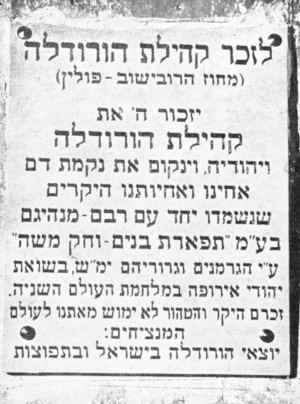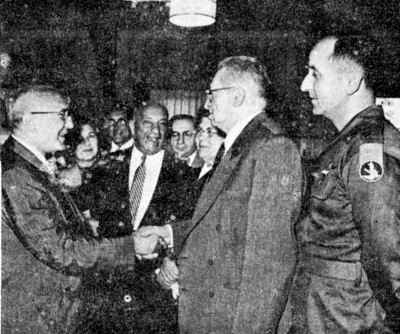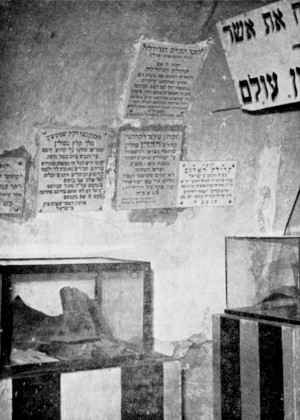[Page 289]
Memorial
In the Holy City of Jerusalem To the Horodlo Jewish Community
[Page 290]
[Blank page]
[Page 291]
|
|
|
[Text on image of Memorial]
In Memory of the Horodlo Jewish Community
(Hrubieszow County, Poland)
May God remember the
Horodlo Jewish community
And its members, and may He take revenge for the blood
Of our dear brothers and sisters
Who were exterminated together with their leader, the Rabbi,
Author of Tiferes-Bonim and Chok Moyshe,
By the Germans and their lackeys, may their memory be blotted out, in the destruction
Of the Jews of Europe during World War Two.
Their precious, pure memory will always be with us,
The memorializers.
Natives of Horodlo in Israel and the Diaspora.
|
| Memorial on Mt. Zion in the Holy City of Jerusalem to the Horodlo Jewish Community |
[Page 292]
Memorial to the Horodlo Jewish Community,
on Mount Zion, in the Holy City of Jerusalem
By Yosef Chaim Zavidovich, Israel
In [the Hebrew month of] Iyar, 1957,[1] a delegation of Zionist activists from the United States came to Israel. Among them was Henech Berman, the son of the Rabbi of Horodlo, the great Rabbi Moyshe HaLevi (may his righteous memory be for a blessing). The delegation members visited many historical sites; they also climbed Mount Zion in the holy city of Jerusalem.
The members first walked around the hill, which is rich in historical memories of the great history of the Jewish people. They immersed themselves in the beautiful location and the clear air, and its associations with the reign of King David and the heroism of Jewish leaders in ancient times, as well as the bravery of present-day Jewish fighters in Israel's War of Liberation. Then they went down into the cellar space that houses the Chamber of the Holocaust.[2] In profound sorrow and pain, they inspected documents concerning the catastrophic destruction of the Jews of Poland and other countries of Europe. The document fragments were collected in the death camps of Poland and Germany, and brought to Mt. Zion.
Trembling with emotion, the members of the delegation studied the searing documents and the stone plaques set into the cellar walls. These memorial inscriptions tell the story of the Jewish communities destroyed by the German murderers and their partners, and bear witness to the suffering of the Jews of Europe, who were killed by their foe.
That is when Henech Berman decided to create a memorial to
[Page 293]
the Jewish community of Horodlo, in the sacred location where the Jewish prophets walked, as well as Jewish kings – chief among them King David – and where Jewish heroes defended Jerusalem in ancient times, as they did during Israel's recent War of Liberation.
|
|
| Henech Berman being greeted by Yitzchak Ben-Zvi, President of Israel |
When Henech Berman returned from his trip to Israel, he told me of his desire to create a memorial to the Horodlo Jewish community in the Chamber of the Holocaust. Both of us went to Jerusalem, where we met with representatives of Israel's Ministry of Religions, which oversees Mount Zion; they agreed to our plan to set up a memorial plaque.
That same day, we brought an expert stone engraver to Mount Zion. After the Mount Zion authorities and
[Page 294]
those in charge of the museum identified a location for the projected plaque, and gave us the project instructions, we gave the artisan the text to be engraved on the memorial.
After he had finished his work and set the stone plaque into the wall of the Chamber, near the memorials to other communities, we, a group of Horodlo natives (including Henech Berman), traveled to the holy city of Jerusalem on April 4, 1957. We climbed Mount Zion and went to the Chamber of the Holocaust to pay our respects to the memory of the Jews of Horodlo and all the martyrs of Europe's Jewish communities.
We directed our glance towards King David's Old City, now in enemy hands, towards the Temple Mount, the site of our destroyed Temple, and towards Mount Scopus.[3] We looked at the Old City wall, and were reminded of the ancient Jewish fortresses and the heroes who defended them. Imbued with the sanctity of the site and the memories of our great Jewish history – memories of the period when the kings of Judah reigned, and the bygone days of glory, with the prophets and the visionaries – we made our way to the Chamber of the Holocaust. Overcome by sorrow and pain, we studied the evidence of the tragic destruction, the collection of the remnants of murder and torture: sacred Torah scrolls steeped in the blood of sacred martyrs, scraps of Torah scroll parchment desecrated by the grisly enemy, tear-soaked sacred books, and boxes with the ashes of our martyrs, who were incinerated in the crematoriums of the abominable Nazis.
We stood there in silence, shivering as we read the words engraved on the Horodlo memorial plaque. We became one with the sacred memory of the Horodlo martyrs and the entire Jewish population that was martyred.
* * *
As the cantor led the memorial service for the Jewish martyrs of Horodlo, next to the final resting place of King David of Israel, he began to chant,
[Page 295]
loudly and clearly, the El Malei Rachamim prayer.[4] When he mentioned the martyrs of Horodlo, we felt that his prayer was becoming part of the prayers of Jewish martyrs and heroes throughout history, prayers that were hovering, shrouded in mystery, throughout the holy city of Jerusalem.
[Page 296]
|
|
The memorial plaque to the Horodlo martyrs
(top row, left) among the memorials to Jewish communities in the Chamber of the Holocaust,
on Mount Zion in the holy city of Jerusalem |
Translator's Footnotes
- The Jewish month of Iyar usually coincides with April-May. Return
- The small “Chamber of the Holocaust” (Hebrew “Cellar of the Catastrophe”), Israel's first Holocaust museum, was established in 1949. Return
- During the years 1948-1967, all of these sites were held by the Kingdom of Jordan, and entry by Jews was prohibited. Return
- Tradition locates the tomb of the biblical King David on Mount Zion, adjoining the Chamber of the Holocaust. The El Malei Rachamim prayer is a plea that the soul of the departed be granted proper rest. Return
This material is made available by JewishGen, Inc.
and the Yizkor Book Project for the purpose of
fulfilling our
mission of disseminating information about the Holocaust and
destroyed Jewish communities.
This material may not be copied,
sold or bartered without JewishGen, Inc.'s permission. Rights may be
reserved by the copyright holder.
JewishGen, Inc. makes no representations regarding the accuracy of
the translation. The reader may wish to refer to the original material
for verification.
JewishGen is not responsible for inaccuracies or omissions in the original work and cannot rewrite or edit the text to correct inaccuracies and/or omissions.
Our mission is to produce a translation of the original work and we cannot verify the accuracy of statements or alter facts cited.
 Horodło, Poland
Horodło, Poland
 Yizkor Book Project
Yizkor Book Project
 JewishGen Home Page
JewishGen Home Page
Yizkor Book Director, Lance Ackerfeld
This web page created by Jason Hallgarten
Copyright © 1999-2025 by JewishGen, Inc.
Updated 15 Jul 2024 by JH





